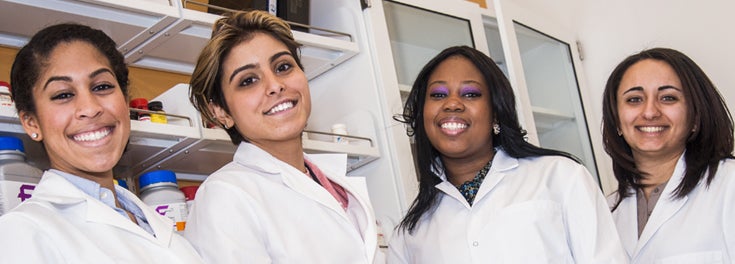
Although the graduate students in URI’s Interdisciplinary Neuroscience Program (INP) have diverse research interests, they share a passion for their work—and belief in the possibilities their projects hold.
For Miriam Dash it’s Alzheimer’s disease research. After earning a B.S. in biology at St. John’s University, with minors in chemistry and psychology, she’s now studying environmental factors relating to Alzheimer’s and drugs to fight the disease. Priscilla Villa graduated from Salve Regina University with a bachelor’s degree in psychology and a minor in biology. As a grad student in the interdisciplinary neuroscience program, she’s focusing on neuromuscular therapy research. And for Octavia Miller, who came to URI from Baltimore’s Morgan State University with a B.S. in biology and a psychology minor, the focus is communicative disorders.
Neuroscientists study the nervous system, how it’s organized, and how it functions. “Neuroscience is one of the last scientific frontiers where fundamental discoveries can still be made,” said Pharmacy Professor Nasser Zawia, director of the program.
Neuroscience is one of the last scientific frontiers where fundamental discoveries can still be made.
If you’re like Miriam, Priscilla or Octavia, ready to break new ground in neuroscience research at URI, you can count on getting broad instruction across several neuroscience disciplines, including the biological sciences, chemistry, engineering, pharmacy, psychology, physical therapy, and communicative disorders.
“The interdisciplinary approach is what enticed me to come to URI,” said Octavia, whose research focuses on the treatment of spastic dysarthria, a speech disorder caused by damage to the central nervous system. She says that while her clinical focus differs from her graduate colleagues, they all benefit from having some classes together. “It allows us to study different aspects of the interdisciplinary program. When I begin my doctorate, it will be very lab-based, so this phase of my study is making me very well-rounded in neuroscience overall.”
Aseel Eid is a UConn grad with a B.S. in physiology and neurobiology, and her INP research focus is multiple sclerosis. She says the program’s interdisciplinary approach “helps remind you why you are here, to do work that directly benefits patients. I love the URI neuroscience program because it requires us to solve real problems, and much of that is done through trial and error. ”
After all, the goal of the Interdisciplinary Neuroscience Program—which offers M.S. and Ph.D. degrees in neuroscience—is to educate scientists and professors who can contribute to private and public sector research. At URI, neuroscience research activity is concentrated in four major areas: dementia and aging, central nervous system disorders, cellular neurobiology, and neural engineering. The program was launched in 2011, and The George & Anne Ryan Institute for Neuroscience, which engages scientists and students in solving some of today’s most pressing health care challenges, was established in 2013.
Pictured above (from left): INP graduate students Miriam Dash, Priscilla Villa, Octavia Miller, and Aseel Eid.
